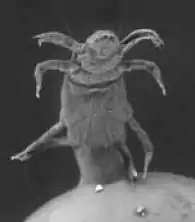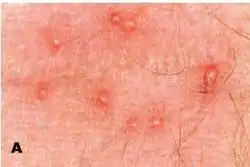Pyemotes herfsi
Pyemotes herfsi, also known as the oak leaf gall mite or itch mite, is an ectoparasitic mite identified in Western Canada in 1923 and subsequently found in India, Asia, and the United States. The mite parasitizes a variety of insect hosts and bites humans, causing red, itchy, and painful wheals (welts). The mites are barely visible, measuring about 0.2-0.8 millimeters; their great reproductive potential, small size, and high capacity for dispersal by wind make them difficult to control or avoid.[1]
| Pyemotes herfsi | |
|---|---|
 | |
| Scientific classification | |
| Kingdom: | |
| Phylum: | |
| Class: | |
| Subclass: | |
| Order: | |
| Family: | |
| Genus: | |
| Species: | P. herfsi |
| Binomial name | |
| Pyemotes herfsi (Oudemans, 1936) | |
Life cycle
Newly emerged and mated females inject a neurotoxin-containing saliva into their hosts, which paralyzes the host and enables the gravid female mites to feed on the host's hemolymph.[1] The posterior portion (opisthosoma) of the female enlarges as its progeny develops inside, and, within a few days, up to 250 adult mites emerge from the gravid female.[1] Bruce and Wrensch (1990) found that progeny of the straw itch mite averaged 254 offspring of which 92% were females. Males emerge before the females, position themselves around the mother's genital opening, and mate with emerging females.[1] Then, mated females disperse to find new hosts.[1] These mites often are dispersed by wind, and when they land on vertebrate hosts, they attempt to feed, resulting in the bites.[1] A life cycle can be completed within seven days, and progeny emergence can be extended to 15 days.[1]
The mites' reported hosts have included Anobium punctatum, the pink bollworm, Grapholita molesta, Tineola bisselliella, Apis cerana (Asiatic honey bee), periodic cicadas, and various pests of stored grain, as well as humans and their pets.[2][3][4] Their usual hosts in the United States are oak midge larvae.[2] Cooler, more moist conditions favor its population growth. Outbreaks of attacks on humans in the United States have been attributed to fluctuations in the supply of oak midge larvae.[1]
Distribution
P. herfsi has been recorded in Czechoslovakia,[5] Egypt,[6] Australia,[7] northern India,[8] and the United States. It is a regulated pest in Germany.[9]
Impact on humans

Rashes resulting from the bite of P. herfsi were first documented in Europe in 1936. The first documented outbreak in the US is thought to have occurred in 1994 in Kansas City, Kansas. The closely related straw itch mite (Pyemotes tritici), was initially suspected, but no specimens of this species were found. The reports indicated that the bites occurred on people after being outdoors in or near wooded areas. Based on this information, a search was initiated and resulted in the discovery of Pyemotes herfsi preying on midge larvae in leaf galls on pin oak trees.
The United States Centers for Disease Control estimated that during an outbreak in August 2004, 54% of the population of Crawford County, Kansas, or about 19,000 people, suffered from its bites.[10] Other states in the US where humans have been affected during the 2000s are Nebraska, Oklahoma, Missouri, Tennessee Shelby County, Texas,[11] and Illinois.[12] In August 2008 an outbreak was reported in the northern suburbs of Cincinnati, Ohio by the Hamilton County Public Health Department.[13]
Humans typically report itching from mite bites within 10 to 16 hours after contact. The victims often do not recall being bitten. The rash that results from the bites is usually described as a red patch with a small blister in the center, most often found on the neck, face, arms, or upper torso. A secondary bacterial infection sometimes arises when the bite is scratched. The suggested treatments include the application of calamine lotion, an antihistamine cream such as diphenhydramine, or a corticosteroid cream; a suggested preventive measure is the application of DEET before outdoor activity.[14] Anecdotal reports from the Kansas outbreak, however, suggest that DEET might not provide complete protection against P. herfsi.[10]
The bites are not life-threatening, but a few individuals suffering 100 or more bites have undergone brief hospitalizations.[15]
References
- This article utilizes text taken verbatim from Pyemotes herfsi (Acari: Pyemotidae), a Mite New to North America as the Cause of Bite Outbreaks, a public domain publication of the United States Department of Agriculture.
- "Pyemotes herfsi (Acari: Pyemotidae), a Mite New to North America as the Cause of Bite Outbreaks" (PDF). USDA. Archived from the original (PDF) on 2011-07-21. Retrieved 2010-04-25.
- Broce AB, Zurek L, Kalisch JA, et al. (May 2006). "Pyemotes herfsi (Acari: Pyemotidae), a mite new to North America as the cause of bite outbreaks". Journal of Medical Entomology. 43 (3): 610–3. doi:10.1603/0022-2585(2006)43[610:PHAPAM]2.0.CO;2. PMID 16739423.
- Richard Jones (2005). Bibliography of Commonwealth Apiculture. Commonwealth Secretariat. p. 104. ISBN 978-0-85092-771-9.
- "Pests that affect human health - Oak leaf Itch Mite" (PDF). Kansas State University. Archived from the original (PDF) on 2011-07-16. Retrieved 2010-04-25.
- Samsinák K, Chmela J, Vobrázková E (1979). "Pyemotes herfsi (Oudemans, 1936) as causative agent of another mass dermatitis in Europe (Acari, Pyemotidae)". Folia Parasitol. 26 (1): 51–4. PMID 156143.
- USDA. A Bibliography of the Pink Bollworm
- Department of Agriculture and Food, Western Australia Archived 2009-06-09 at the Library of Congress Web Archives
- Proceedings of the Indian Academy of Sciences
- Biologische Bundesanstalt für Land- und Forstwirtschaft
- Centers for Disease Control and Prevention (CDC) (September 2005). "Outbreak of pruritic rashes associated with mites--Kansas, 2004". MMWR Morb Mortal Wkly Rep. 54 (38): 952–5. PMID 16195693.
- University of Nebraska, May 2, 2005 Archived August 16, 2007, at the Wayback Machine
- Chicago Tribune, August 14, 2007
- WLWT TV, Cincinnati, Ohio, August 26, 2008
- University of Nebraska, 2005 Archived 2007-08-16 at the Wayback Machine
- University of Nebraska, July 2005 Archived 2006-05-09 at the Wayback Machine